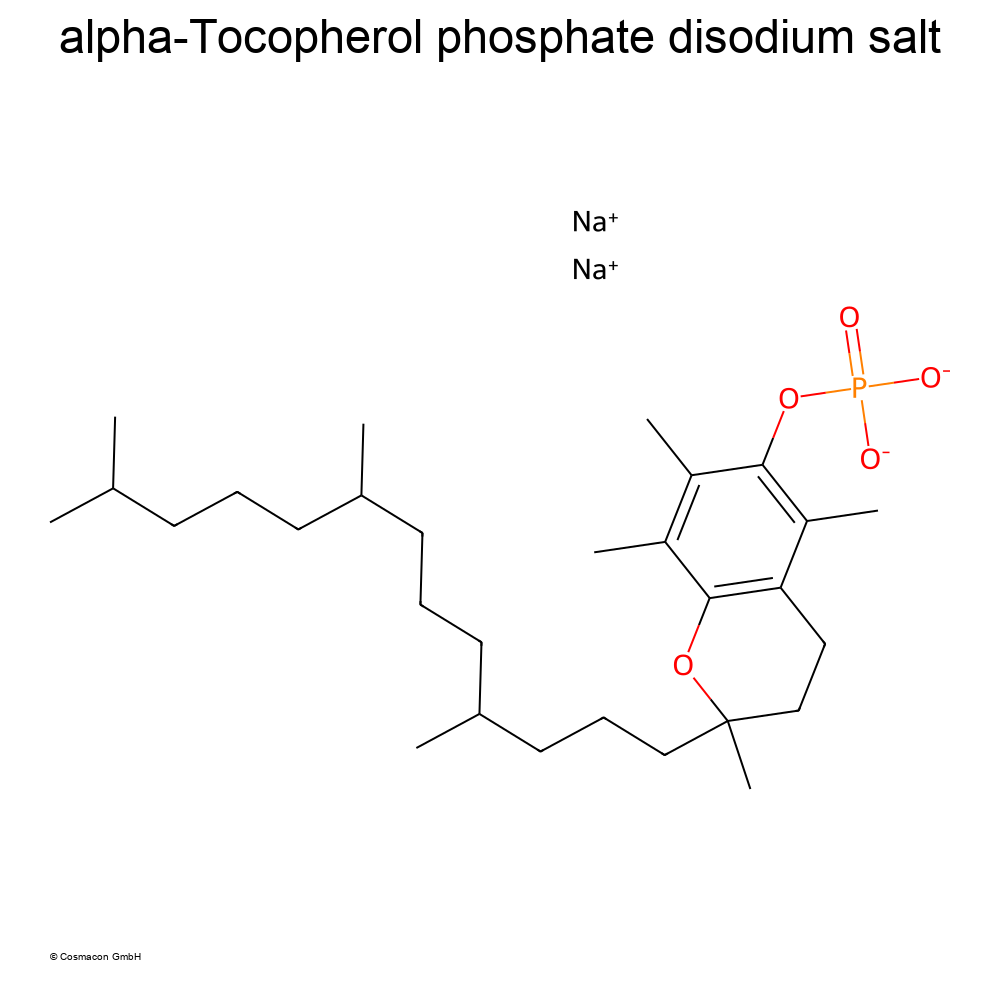Sodium Tocopheryl Phosphate – water-soluble vitamin E

Sodium Tocopheryl Phosphate, or TPNa for short, is a breakthrough cosmetic active ingredient that combines the benefits of vitamin E with the properties of modern cosmetic formulations. In this article, we take a detailed look at TPNa, highlighting its chemical and physical properties, discussing its efficacy, advantages and disadvantages, and discussing its uses in cosmetic products.
What is Sodium Tocopheryl Phosphate?
TPNa is a water-soluble derivative of tocopherol (vitamin E) that is produced by chemically modifying it with phosphoric acid. This compound is particularly interesting for the cosmetics industry because it combines the benefits of vitamin E, such as antioxidant and cell-protecting properties, with improved stability and water solubility.
Chemical-physical data of TPNa
INCI name: Sodium Tocopheryl Phosphate
Molecular formula: C31H52O7PNa
Appearance: White to slightly yellowish powder
Physical state: Solid
Melting point: Approx. 80–90 °C
Solubility: Freely soluble in water
CAS number: 7695-91-2
Alternative names: Sodium D-alpha-Tocopheryl Phosphate, Vitamin E Phosphate
Advantages of Sodium Tocopheryl Phosphate
Skin protection through antioxidant properties: TPNa acts as a powerful antioxidant that neutralizes free radicals and thus protects the skin from premature aging and harmful environmental influences.
Stability and formulability: Unlike pure vitamin E, TPNa is more stable against light, oxygen and heat. This property makes it ideal for processing in cosmetic products, especially in aqueous formulations such as serums or gels.
Anti-inflammatory: Studies show that sodium tocopheryl phosphate can reduce inflammatory processes in the skin, making it ideal for the care of sensitive and irritated skin.
Antibacterial effect: TPNa is effective against Propionibacterium acnes, which is responsible for acne breakouts, making it an excellent choice for skin care products for blemished skin.
Moisturizing: It helps maintain skin moisture and ensures a smooth and supple complexion (in-vitro).
Disadvantages of TPNa
Cost: Sodium Tocopheryl Phosphate is more expensive than conventional antioxidants due to its elaborate manufacturing process. This higher raw material cost may affect the final price of the product.
Concentration dependence: The efficacy of TPNa depends strongly on the concentration used. Studies show that a concentration of 1-3% is ideal for achieving optimal results. However, higher concentrations can significantly increase the formulation costs.
Limited effect on very dry skin: For extremely dry skin, TPNa alone may not be sufficient and should be combined with other moisturizing active ingredients.
Effectiveness and ideal concentration
Scientific research shows that TPNa has an anti-inflammatory effect at a concentration of 1% and provides significant antioxidant protection at 2-3%. These concentrations are therefore particularly popular in cosmetic products such as serums, creams and masks. A study of acne patients showed that products with 3% TPNa reduced inflammatory lesions by up to 40% after four weeks, while also improving skin texture.
Applications in cosmetics
Anti-ageing products: Thanks to its antioxidant and cell-protecting properties, TPNa is ideal for anti-ageing creams and serums. It helps to reduce wrinkles and strengthen the skin barrier.
Sensitive skin products: Its anti-inflammatory properties make TPNa an excellent choice for products designed specifically for sensitive or irritated skin.
Acne treatments: TPNa can be used in toners, creams and gels to reduce acne breakouts and soothe the skin.
Moisturizing care: in lotions and moisturizing gels, it leaves the skin feeling supple and hydrated.
Sun care products: combined with UV filters, TPNa can protect the skin from oxidative stress caused by UV radiation.
After-sun care: it helps to soothe sun-stressed skin and promote recovery.
Product ideas with Sodium Tocopheryl Phosphate
Hydrating Antioxidant Serum: A light, moisturizing formula with 2% TPNa for a fresh complexion.
Anti-Acne Spot Treatment: A concentrated gel with 3% TPNa and salicylic acid that targets blemishes.
Reparative Night Cream: A rich night cream with 1.5% TPNa and hyaluronic acid to regenerate the skin overnight.
Brightening Eye Cream: A gentle eye cream that reduces dark circles and smoothes fine lines.
Conclusion
Sodium Tocopheryl Phosphate is a versatile active ingredient that offers the benefits of vitamin E in a more stable and better formulated form. Its antioxidant, anti-inflammatory and antibacterial properties make it an indispensable ingredient in modern cosmetics.
Cosmacon GmbH can help you develop innovative cosmetic products with TPNa that will set your brand apart from the competition. Our expertise in formulating high-quality, effective and stable cosmetic products ensures that your products meet the highest standards. Contact us to turn your ideas into reality!
Literature:
Kato E, Sasaki Y, Takahashi N.Bioorg Med Chem. 2011 Nov 1;19(21):6348-55